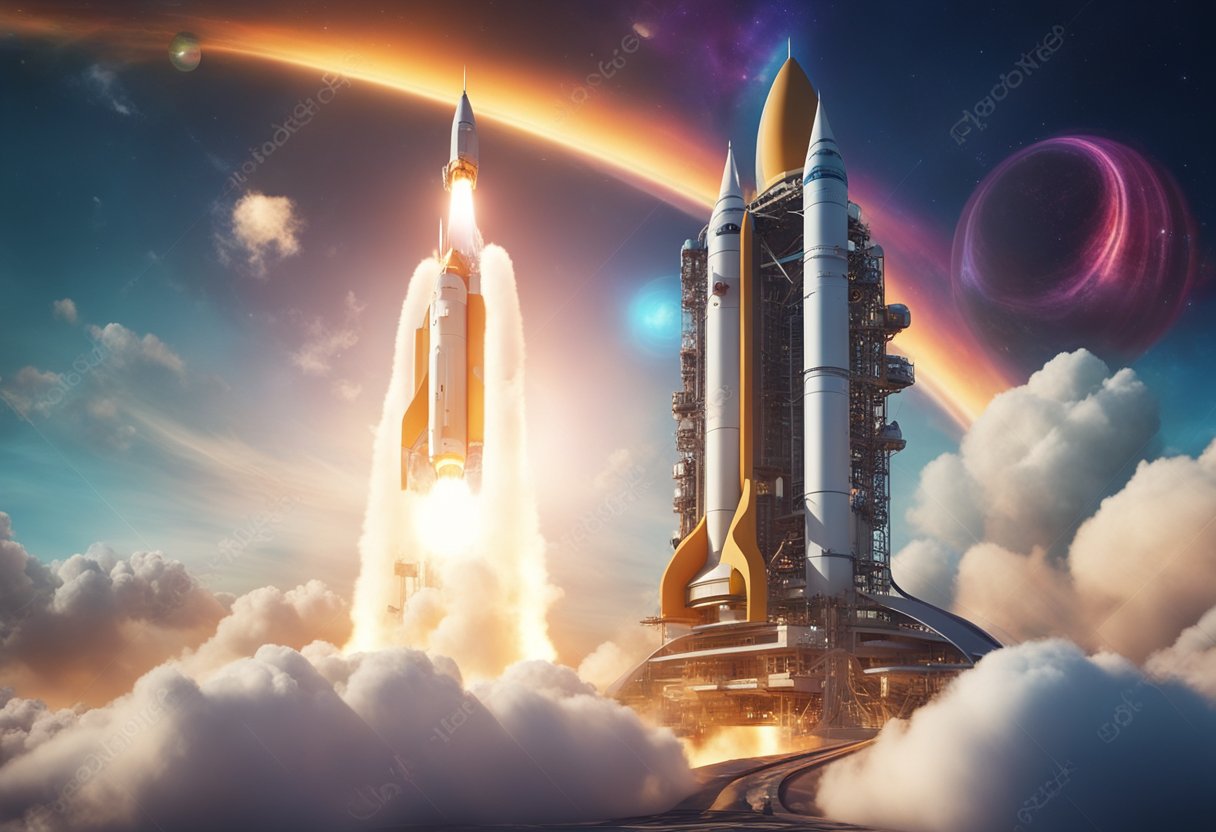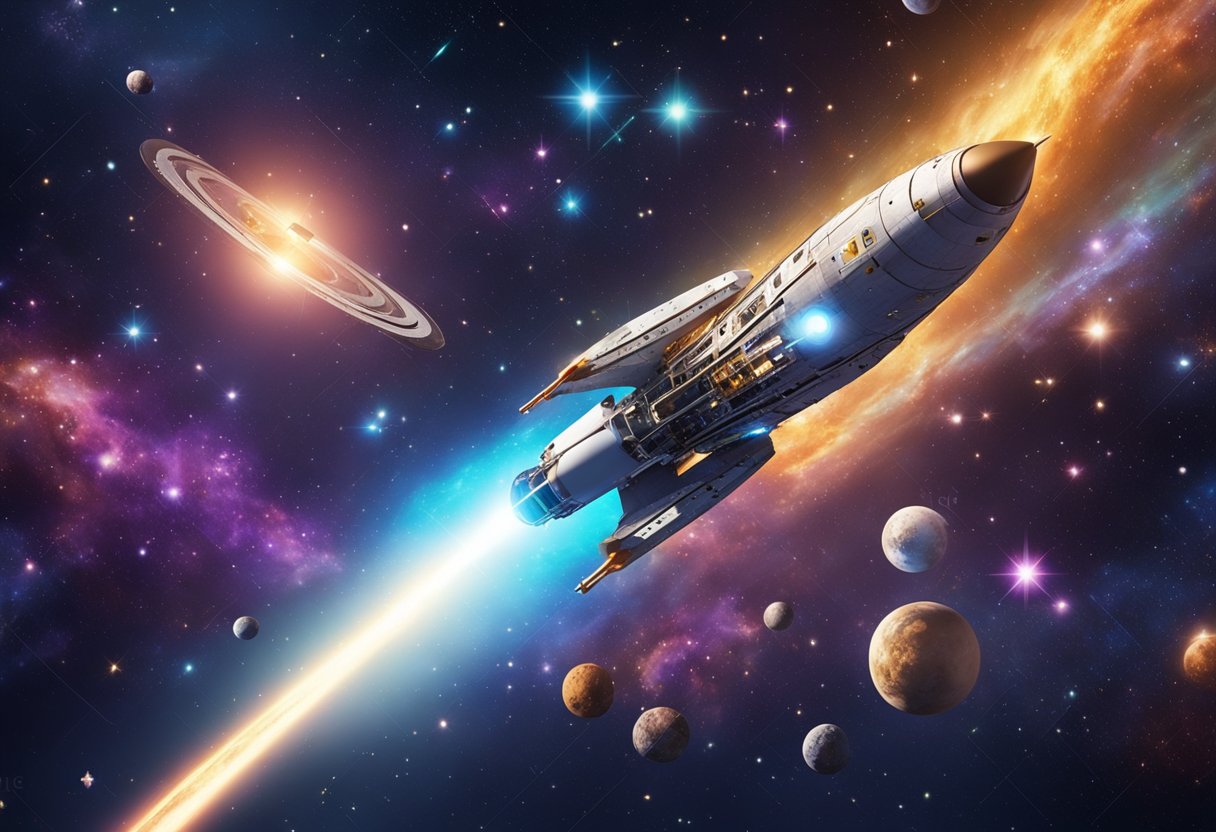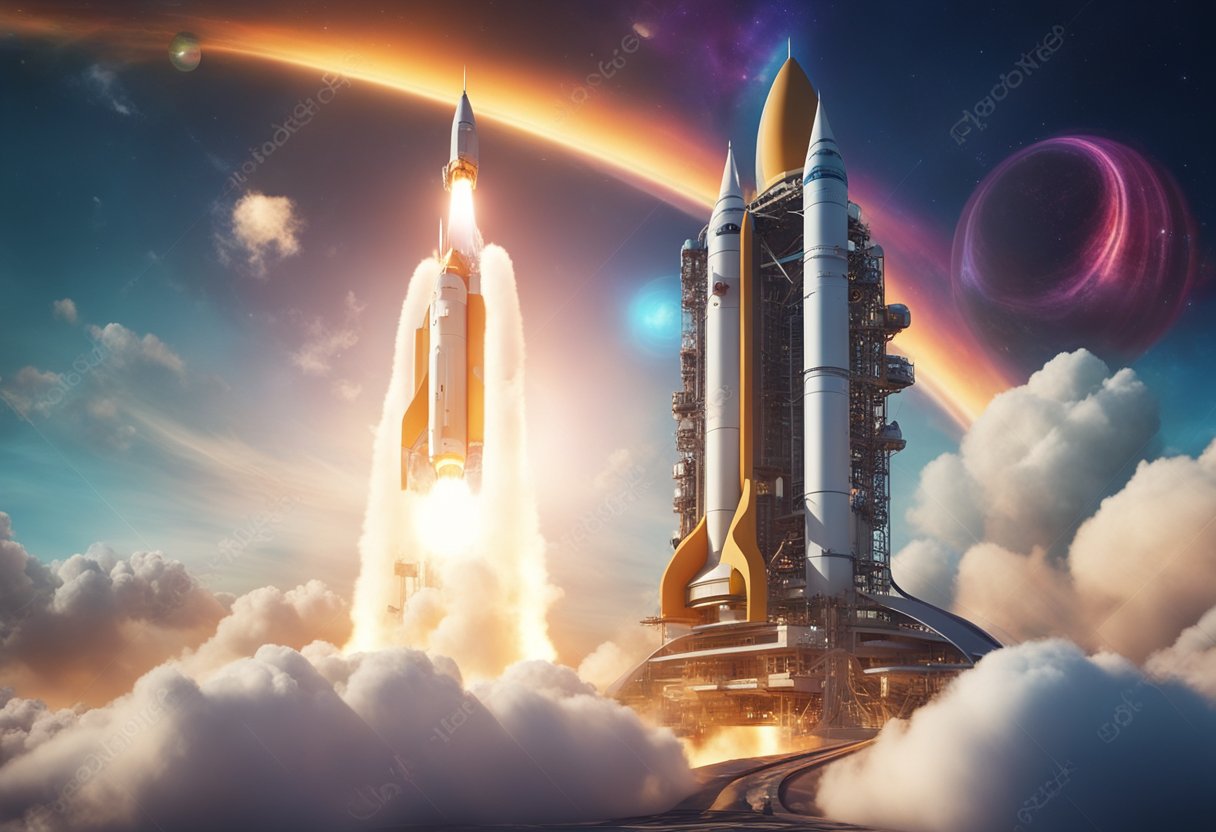
Space Travel Guide: Embarking on a journey beyond the Earth’s atmosphere once seemed like a distant dream, but space travel is fast becoming a palpable reality. We now live in an era where the cosmos are opening up to us, offering opportunities not just for astronauts but for anyone with a yearning for the ultimate adventure. With companies racing to perfect their spaceflight technologies, the chance to gaze upon the stars from the other side of our atmosphere is closer than ever before.

As we prepare for this new chapter in exploration, it’s crucial to understand what it entails to become a space traveller. The thrill of zero gravity and the awe of seeing Earth from space come with a significant amount of preparation. Both physical and mental fitness are key, and choosing the right company to facilitate the journey is just as important. Prospective space tourists must consider safety protocols, types of vehicles used for spaceflight, and the intricacies of life in orbit.
As interest in space tourism grows, we must understand the intricacies involved in embarking on such a unique journey. From understanding what encompasses space travel to the training involved, and the essential documentation required, we lay out the key steps one should be aware of.
Space Travel refers to our journey beyond Earth’s atmosphere. This can include trips to orbit, the International Space Station (ISS), or even to the Moon. Planning for space travel begins with purchasing a ticket through a reputable space agency or authorised private company. Currently, venture companies like SpaceVoyageVentures.com provide insightful perspectives on the burgeoning opportunities for aspiring space tourists, from upcoming launches to those nearly available for the public.
Before embarkation, extensive training is crucial for a safe and enjoyable experience:
Astronauts train for months, even years; however, for tourists, the duration will be shorter yet intense.
Essential documentation for space travel includes:
Keeping these documents ready is as crucial as the physical and mental preparations for space travel. Our journey to the stars requires a meticulous approach to ensure safety and compliance with international space regulations.
Remember, a typical launch involves rigorous checks and clearances, and upon your return, your passport may receive a special stamp from your space travel – a reminder of the incredible journey you undertook.

When selecting a space travel company, it is crucial to consider their experience, cost options, and safety records. The rapidly growing space tourism industry offers various opportunities, but careful selection is paramount for a fulfilling experience.
To journey into space, one must examine the leaders in the industry. Virgin Galactic is renowned for its suborbital spaceflights, offering travellers a glimpse of space without orbiting the Earth. Blue Origin, with its New Shepard suborbital vehicle, provides a similar experience. Meanwhile, SpaceX has positioned itself as a provider for orbital flights, with plans to transport individuals beyond the International Space Station. For up-and-coming details on the field, one can look at fresh resources such as SpaceVoyageVentures.com, which catalogues both current and prospective space tourism adventures.
The cost of space travel is significant, with current prices ranging from hundreds of thousands to millions of dollars. It remains an endeavour for those with a substantial budget. For instance, a ticket with Virgin Galactic is priced at around $250,000. When planning for space tourism, it’s essential to consider the entire package, including pre-flight training and potential add-ons.
Safety is paramount in the selection process, and scrutinising each company’s safety records is a must. The companies are at various stages of testing and development, with NASA’s decades of spaceflight experience serving as a benchmark for safety procedures. As the industry matures, safety measures continue to evolve, and one must remain informed about the latest advancements and incident reports.
Our collective understanding of the space tourism industry will grow, and we must remain vigilant in our research to ensure safe and extraordinary cosmic voyages.
We are witnessing an era where the boundaries of space exploration are continually expanding, thanks to innovative vehicles ranging from rockets to sophisticated spacecraft. These vehicles are at the forefront of our journey beyond Earth, each designed with specific capabilities to traverse the vast expanse of space.
Rockets are the initial driving force behind space travel, propelling spacecraft beyond the Earth’s atmosphere. They consist of engines that burn fuel to create a high-speed stream of gases, expelling them to thrust the rocket upwards. A key vehicle in this domain includes the renowned space shuttle, a partially reusable spacecraft that significantly contributed to our space expeditions.
On the other hand, spacecraft like the Dragon capsule have become synonymous with modern space exploration. Originally developed by SpaceX, this spacecraft has revolutionised how we approach both crewed and uncrewed missions, acting as a reliable transport vessel for astronauts and cargo to low-Earth orbit.
The push towards reusability in rocketry aims to reduce the cost of access to space. Technologies developed by various aerospace firms have paved the way for rockets that can not only take off but also return and land back on Earth. SpaceX has been a pioneer in this field, successfully landing and reusing their Falcon 9 first stages, which has been a monumental step in sustainable space exploration.
Our use of advanced technology in the development of spacecraft has expanded our capabilities and reduced reliance on expendable vehicles. Innovative navigation systems, efficient propulsion technologies, and life-support systems in spacecraft are all critical facets that support our exploratory missions and the potential for space tourism ventures, as highlighted on websites like SpaceVoyageVentures.com.
Through continuous improvements in these vehicles, we are progressing further in our quest to explore the cosmos, reaching new frontiers and broadening our understanding of space.
As we embark on the extraordinary venture of space travel, it’s pertinent that we comprehend the intricacies involved, from the launch procedures to the nuances of reaching orbit.
Pre-flight Checks: Prior to any rocket launch, a series of stringent checks must be conducted. This includes verifying the spacecraft’s systems, ensuring the payload is secure, and confirming the weather conditions are favourable. We meticulously review communication links and ground operations to ensure everything is in place for a successful lift-off.
Countdown and Ignition: The final moments before take-off are pivotal. Our countdown process involves the synchronisation of all systems, and once all systems are ‘go’, the rocket’s engines are ignited. This leads us into the controlled and powerful ascent through Earth’s atmosphere.
Ascent Trajectory: Once launched, the rocket must achieve a precise trajectory. Orbital mechanics dictate the path and speed of the craft to reach and maintain a stable orbit. The rocket’s engines thrust it into space, gradually transitioning from a vertical ascent to a horizontal orientation, aligning with our planet’s curvature.
Achieving Low Earth Orbit: Finalising our journey to space involves entering low earth orbit (LEO). Here, we are approximately 2,000 kilometres above the Earth, moving at speeds that balance the pull of gravity against our outward inertia – this is what keeps us orbiting the Earth.
To learn more about space tourism and the experiences we may soon enjoy, including trips currently in development, visit SpaceVoyageVentures.com.
When embarking on a journey beyond our planet, it’s essential to understand what life in space entails. From the quirks of microgravity to the importance of conducting research and the typical daily routines of astronauts, living in orbit presents unique challenges and opportunities.
The sensation of weightlessness, or more accurately, microgravity, is a fundamental aspect of space travel. In the absence of Earth’s gravity, astronauts float inside the spacecraft, which requires them to adapt to new ways of moving and working. This novel environment can present initial disorientation, but it also allows for incredible experiences such as spacewalks outside the craft to perform maintenance or scientific tasks.
Our capacity to perform experiments in space unlocks a multitude of opportunities. The unique conditions of microgravity allow us to explore physics, biology, and chemistry in ways not possible on Earth. From observing the behaviour of flames to monitoring the growth of crystals, the astronauts serve as both scientists and subjects in our quest to expand human knowledge.
Life aboard a spacecraft involves a structured schedule to ensure all necessary activities are accomplished. Astronauts follow regular rituals for working, exercising, eating, and sleeping. Similar to Earth, they work around a 24-hour cycle with allocated time for each activity, including up to two hours of exercise each day to prevent muscle atrophy and bone density loss due to microgravity.
By learning more about life in space, we at SpaceVoyageVentures.com contribute to the broader understanding of human spaceflight and its future potential, paving the way for not only professional astronauts but also for the burgeoning field of space tourism.

In our quest for cosmic exploration, we focus on two primary celestial bodies that continue to captivate our imagination and scientific curiosity: the Moon and Mars. These destinations hold the promise of untapped discoveries and represent the zenith of human pioneering in space.
The Moon, Earth’s only natural satellite, has been the subject of human fascination and lunar explorations for decades. Our lunar journeys have allowed us to collect valuable moon rocks and observe phenomena such as solar eclipses from a unique vantage point. Our future expeditions aim to further explore its desolate beauty and potential resources. The Moon’s surface, marked by vast plains and craters, offers a glimpse into the history of our solar system. Trips to the Moon might soon be a must-see on every space traveller’s itinerary, as indicated on SpaceVoyageVentures.com.
Exploring Mars opens doors to the possibilities of life beyond Earth and deepens our understanding of interplanetary travel. Envision settling in a habitat on the red plains, examining the Martian soil, and potentially uncovering signs of past microbial life. As we push the boundaries of space exploration, the very essence of Mars beckons us to venture further into our solar system. SpaceVoyageVentures.com details the progress of missions that could soon make travelling to Mars an attainable goal, marking a monumental step in our interplanetary travel guide.
Space tourism is rapidly transitioning from a lofty dream to a tangible reality, with companies like Virgin Galactic and Blue Origin paving the way. These ventures are not just about reaching new heights but also about offering unparalleled experiences such as the awe-inspiring overview effect.
We are entering an era where commercial spaceflights are more than science fiction. Companies like Virgin Galactic and Blue Origin have developed programmes designed to take tourists beyond the confines of Earth. Virgin Galactic’s VSS Unity spaceplane aims to provide passengers with several minutes of weightlessness and an astonishing view of our planet against the vastness of space. Blue Origin’s New Shepard suborbital vehicle promises a similar experience, with both endeavours emphasizing safety and accessibility to make dreams of orbit attainable.
Suborbital space tourism offers a shorter journey where participants experience weightlessness for a few minutes without completing an orbital circuit around the Earth. During these trips, passengers aboard specialised aircrafts like the ‘vomit comet’ experience microgravity in a controlled environment, often as a precursor to more ambitious space travel. The overview effect, a cognitive shift in awareness reported by some astronauts during spaceflight, is also a profound experience that suborbital travellers might encounter, changing their perspective on life and our planet.
We’re at the forefront of this new frontier, and at SpaceVoyageVentures.com, we document the possible future trips both available and nearly available, making space tourism an accessible experience for those who dream of the stars.
When preparing for space travel, understanding and implementing rigorous safety and emergency protocols is paramount. These measures not only ensure the well-being of astronauts but also safeguard the integrity of the mission.
To effectively deal with emergencies, we must have a comprehensive grasp of potential scenarios and the respective contingency plans. Our training involves meticulous rehearsal of procedures to address common in-orbit emergencies such as fire, cabin depressurisation, and medical crises. A robust communication system is crucial for relaying information to ground control and coordinating a prompt response. Devising multiple backup systems ensures that, in the event of equipment failure, we can maintain mission integrity without compromise.
Broadly speaking, dangers in space are fundamentally different from Earth-bound risks. We must acknowledge the omnipresent risk of radiation from solar flares and cosmic rays, which can have severe effects on health. Our crafts are equipped with shielding to partially mitigate this hazard. In addition, the atmosphere, or rather the lack thereof in the vacuum of space, poses a unique set of challenges wherein even a minor breach in the hull can prove catastrophic. Our rigorous safety records are a testament to the effective management of such risks.
Our commitment to safety has been shaped by past experiences and the evolution of space technology. We incorporate lessons learned into evolving best practices. Keeping abreast with sites like SpaceVoyageVentures.com, we gather insights into the continual advancements in space tourism and the vital safety measures adopted across the industry.
Before we discuss the details, it’s essential to understand that returning from space is an intricately managed process, focusing on safety and precision during the re-entry and landing phases, influenced heavily by gravity and speed.
Re-entry is a critical phase that involves our spacecraft transitioning from the vacuum of space back into Earth’s atmosphere. The physics of re-entry is driven by gravity as the Earth pulls the spacecraft in its direction. As the craft descends, it must decelerate from orbital speeds of up to 28,000 kilometres per hour to a speed that ensures safe landing.
Speed management is handled by the spacecraft’s attitude control system which adjusts the craft’s angle to balance lift and drag, thus controlling the descent speed and heat generation. We employ thermal protection systems to ensure the integrity of the craft as it endures the enormous temperatures produced by atmospheric friction.
Post re-entry, the next phase is landing. For a successful landing, we deploy parachutes or utilise retro rockets to further slow down the spacecraft for a safe touchdown, whether on land or at sea. After landing, recovery teams are dispatched promptly to locate and assist the astronauts in exiting the spacecraft.
Our recovery operations are meticulously planned and rehearsed to account for multiple scenarios, ensuring that no matter where our craft lands, a team will be within reach to ensure the swift and safe retrieval of our crew and equipment.
For more insight into the intricacies of these operations and the future of space tourism, you may explore SpaceVoyageVentures.com, which archives potential and forthcoming space tourism opportunities.
In this section, we will explore how recent technological advancements and increased international collaboration are shaping the trajectory of space exploration and travel.
The evolution of rocket technology is pivotal to the sustainability and accessibility of space travel. Notably, companies like SpaceX have been at the forefront with their reusable rocket systems. The Falcon Heavy, championed by Elon Musk, significantly reduces costs, marking a leap towards more economical space voyages. Moreover, NASA’s Space Launch System (SLS) is setting the stage for deep space missions, including crewed lunar landings.
Our venture into space is not a solitary journey; it requires global cooperation. NASA collaborates with various countries’ space agencies and private firms, which has become the norm for ambitious projects like the Artemis program. Additionally, figures like Richard Branson exemplify leadership in space tourism, with Virgin Galactic working alongside international partners to bring suborbital flights to the public.
Our presence on SpaceVoyageVentures.com emphasises our commitment to sharing and documenting the historic and future milestones of both entry-level and advanced space tourism. Here, we provide a window into the experiences soon to be available to the intrepid traveller.
In this section, we address some of the most pressing queries regarding space travel, from the costs involved to the educational materials for budding astronomers.
Commercial space travel is still in the realm of luxury tourism, with prices ranging substantially depending on the experience offered. Seats on short suborbital flights can cost hundreds of thousands of pounds, while proposals for orbital experiences suggest even higher costs.
To become a space tour guide, one would need a thorough understanding of spacecraft operations and safety procedures. Astronomical knowledge, along with top-notch communication skills, would also be essential to effectively engage tourists and convey complex information clearly.
Preparing for outer space involves rigorous physical and psychological training. Prospective space travellers must pass medical exams and undergo training to deal with microgravity environments. Additionally, learning about spacecraft systems and operations is a critical component of mission preparation.
The primary modes of space exploration today include robotic spacecraft, such as probes and rovers, for distant celestial bodies; manned missions for more in-depth exploration; and the International Space Station as a hub for scientific research and international cooperation.
Stargazers should familiarise themselves with the current positions of constellations, planets, and celestial events such as meteor showers. Knowledge of using telescopes and understanding atmospheric conditions can greatly enhance the stargazing experience.
For children interested in astronomy, interactive planetarium apps and astronomy-themed educational kits can be highly beneficial. Additionally, visiting local observatories and participating in astronomy clubs or events can provide valuable practical experience.